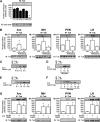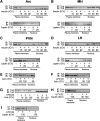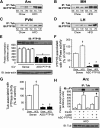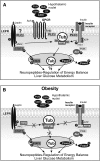Tub has a key role in insulin and leptin signaling and action in vivo in hypothalamic nuclei
- PMID: 22966070
- PMCID: PMC3526052
- DOI: 10.2337/db11-1388
Tub has a key role in insulin and leptin signaling and action in vivo in hypothalamic nuclei
Retraction in
-
Statement of Retraction. Tub Has a Key Role in Insulin and Leptin Signaling and Action In Vivo in Hypothalamic Nuclei. Diabetes 2013;62:137-148. DOI: 10.2337/db11-1388.Diabetes. 2017 Mar;66(3):785-786. doi: 10.2337/db17-rt03a. Epub 2017 Feb 10. Diabetes. 2017. PMID: 28188142 Free PMC article. No abstract available.
Expression of concern in
-
Expression of Concern. Tub Has a Key Role in Insulin and Leptin Signaling and Action In Vivo in Hypothalamic Nuclei. Diabetes 2013;62:137-148. DOI: 10.2337/db11-1388.Diabetes. 2016 Apr;65(4):1121-2. doi: 10.2337/db16-ec04. Diabetes. 2016. PMID: 27208021 Free PMC article. No abstract available.
Abstract
Mutation of tub gene in mice induces obesity, suggesting that tub could be an important regulator of energy balance. In the current study, we investigated whether insulin, leptin, and obesity can modulate Tub in vivo in hypothalamic nuclei, and we investigated possible consequences on energy balance, neuropeptide expression, and hepatic glucose metabolism. Food intake, metabolic characteristics, signaling proteins, and neuropeptide expression were measured in response to fasting and refeeding, intracerebroventricular insulin and leptin, and Tub antisense oligonucleotide (ASO). Tub tyrosine phosphorylation (Tub-p-tyr) is modulated by nutritional status. Tub is a substrate of insulin receptor tyrosine kinase (IRTK) and leptin receptor (LEPR)-Janus kinase 2 (JAK2) in hypothalamic nuclei. After leptin or insulin stimulation, Tub translocates to the nucleus. Inhibition of Tub expression in hypothalamus by ASO increased food intake, fasting blood glucose, and hepatic glucose output, decreased O(2) consumption, and blunted the effect of insulin or leptin on proopiomelanocortin, thyroid-releasing hormone, melanin-concentrating hormone, and orexin expression. In hypothalamus of mice administered a high-fat diet, there is a reduction in leptin and insulin-induced Tub-p-tyr and nuclear translocation, which is reversed by reducing protein tyrosine phosphatase 1B expression. These results indicate that Tub has a key role in the control of insulin and leptin effects on food intake, and the modulation of Tub may contribute to insulin and leptin resistance in DIO mice.
Figures








Similar articles
-
Reduction of hypothalamic protein tyrosine phosphatase improves insulin and leptin resistance in diet-induced obese rats.Endocrinology. 2008 Aug;149(8):3870-80. doi: 10.1210/en.2007-1506. Epub 2008 May 8. Endocrinology. 2008. PMID: 18467448 Free PMC article.
-
Inhibition of hypothalamic Foxo1 expression reduced food intake in diet-induced obesity rats.J Physiol. 2009 May 15;587(Pt 10):2341-51. doi: 10.1113/jphysiol.2009.170050. Epub 2009 Mar 30. J Physiol. 2009. PMID: 19332486 Free PMC article.
-
Hypothalamic growth hormone receptor (GHR) controls hepatic glucose production in nutrient-sensing leptin receptor (LepRb) expressing neurons.Mol Metab. 2017 Mar 16;6(5):393-405. doi: 10.1016/j.molmet.2017.03.001. eCollection 2017 May. Mol Metab. 2017. PMID: 28462074 Free PMC article.
-
Leptin receptor signaling and the regulation of mammalian physiology.Recent Prog Horm Res. 2004;59:287-304. doi: 10.1210/rp.59.1.287. Recent Prog Horm Res. 2004. PMID: 14749507 Review.
-
Leptin signaling, adiposity, and energy balance.Ann N Y Acad Sci. 2002 Jun;967:379-88. doi: 10.1111/j.1749-6632.2002.tb04293.x. Ann N Y Acad Sci. 2002. PMID: 12079865 Review.
Cited by
-
Central regulation of metabolism by protein tyrosine phosphatases.Front Neurosci. 2013 Jan 7;6:192. doi: 10.3389/fnins.2012.00192. eCollection 2012. Front Neurosci. 2013. PMID: 23308070 Free PMC article.
-
The STK33-linked SNP rs4929949 is associated with obesity and BMI in two independent cohorts of Swedish and Greek children.PLoS One. 2013 Aug 15;8(8):e71353. doi: 10.1371/journal.pone.0071353. eCollection 2013. PLoS One. 2013. PMID: 23967198 Free PMC article.
-
Retracted: Treadmill Training Increases SIRT-1 and PGC-1α Protein Levels and AMPK Phosphorylation in Quadriceps of Middle-Aged Rats in an Intensity-Dependent Manner.Mediators Inflamm. 2017;2017:8287646. doi: 10.1155/2017/8287646. Epub 2017 Oct 16. Mediators Inflamm. 2017. PMID: 29123335 Free PMC article.
-
Gene expression atlas of energy balance brain regions.JCI Insight. 2021 Aug 23;6(16):e149137. doi: 10.1172/jci.insight.149137. JCI Insight. 2021. PMID: 34283813 Free PMC article.
-
A homozygous mutation in the TUB gene associated with retinal dystrophy and obesity.Hum Mutat. 2014 Mar;35(3):289-93. doi: 10.1002/humu.22482. Epub 2013 Dec 20. Hum Mutat. 2014. PMID: 24375934 Free PMC article.
References
-
- Belgardt BF, Brüning JC. CNS leptin and insulin action in the control of energy homeostasis. Ann N Y Acad Sci 2010;1212:97–113 - PubMed
-
- Carvalheira JB, Torsoni MA, Ueno M, et al. Cross-talk between the insulin and leptin signaling systems in rat hypothalamus. Obes Res 2005;13:48–57 - PubMed
-
- Morton GJ, Schwartz MW. The NPY/AgRP neuron and energy homeostasis. Int J Obes Relat Metab Disord 2001;25(Suppl 5):S56–S62 - PubMed
-
- Woods SC, Schwartz MW, Baskin DG, Seeley RJ. Food intake and the regulation of body weight. Annu Rev Psychol 2000;51:255–277 - PubMed
Publication types
MeSH terms
Substances
LinkOut - more resources
Full Text Sources
Medical
Molecular Biology Databases
Miscellaneous

